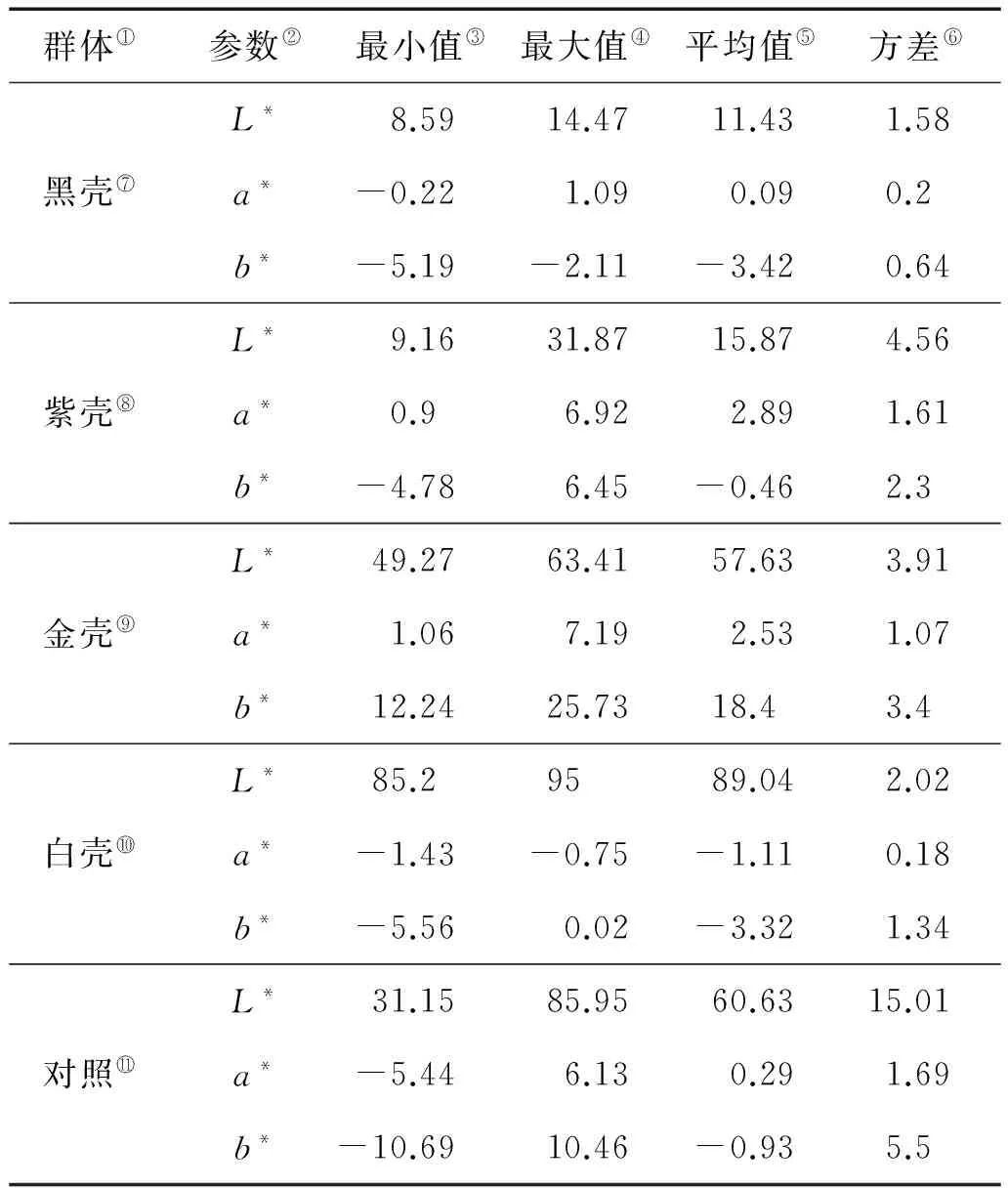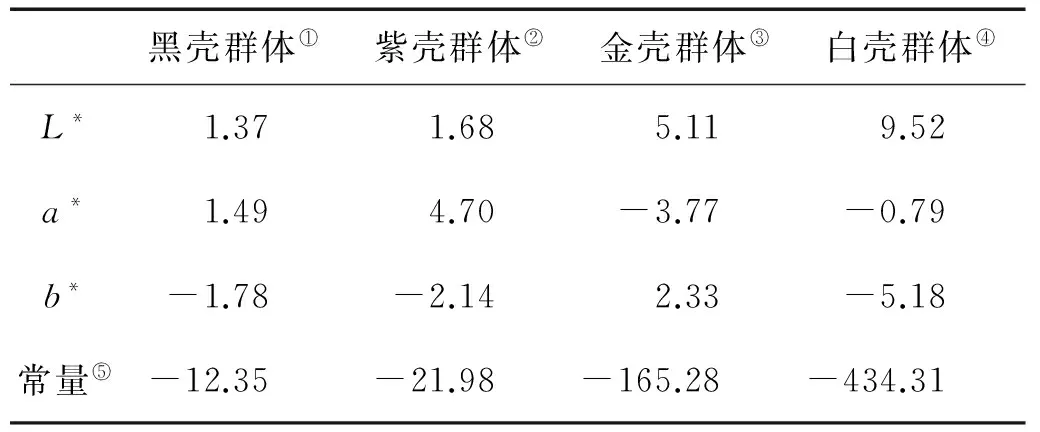长牡蛎四种壳色选育系壳色性状的量化分析❋
2018-12-13宋俊霖孔令锋
宋俊霖, 李 琪, 孔令锋
(海水养殖教育部重点实验室(中国海洋大学),山东 青岛 266003)
长牡蛎四种壳色选育系壳色性状的量化分析❋
宋俊霖, 李 琪**, 孔令锋
(海水养殖教育部重点实验室(中国海洋大学),山东 青岛 266003)
壳色是长牡蛎(Crassostreagigas)重要的可遗传经济性状,对壳色进行量化分析可为长牡蛎壳色判定提供有效方法。本研究运用国际照明委员会(CIE)L*a*b*颜色模型评估了黑壳、紫壳、白壳和金壳4个长牡蛎选育群体以及1个普通养殖群体的贝壳颜色参数(L*、a*和b*)。对比壳色参数,结果显示,L*、a*、b*值的方差均小于普通养殖群体,表明经过继代选育,纯化的壳色已经得到较稳定的遗传。通过主成分分析,从3个参数中提取了2个主成分(PC1和PC2),分别解释了53.09% 和38.89%变异,PC1解释大部分变异且PC1中参数a*负荷值最大,表明影响壳色不同的主要因素是参数a*。通过逐步判别法分析黑壳、紫壳、白壳和金壳长牡蛎群体,建立了4个判别方程,4种壳色综合判别准确率为96.05% ,说明该判别方程在实际应用时参考价值较大。
长牡蛎;壳色;量化分析;判别分析
海洋贝类中普遍存在壳色多态性。丰富多彩的壳色品种在受到消费者青睐的同时也提高了商品的经济价值,颜色已成为一种重要的经济性状。大量研究表明,壳色主要由遗传因素决定[1-2],并且与生长、存活等性状有密切关联[3-6]。因此,壳色作为一种可稳定遗传的性状,已经成为贝类遗传育种的一个研究热点。目前,以壳色为目标性状进行纯色系的定向选育,在多种经济贝类中已取得了重要进展,例如:在马氏珠母贝(Pinctadamartensii)培育出红色、红褐色、黄色和白色4种壳色选育系[7],在文蛤(Meretrixmeretrix.)培育出青灰色、淡黄色、灰白色等壳色群体[8],在海湾扇贝(Argopectenirradians)有灰色、棕色、黄色、橙色、紫色等壳色群体[9]。
长牡蛎(Crassostreagigas)又称太平洋牡蛎,具有适应性强、生长快、肉质细腻且营养丰富等优点,是世界上养殖范围最广、产量最高的经济贝类。2015年中国牡蛎年产量高达457万t,占全国贝类产量的33.7%[10],牡蛎养殖在我国海产贝类养殖业中占有重要地位。目前长牡蛎养殖中存在性状退化、品质下降等问题,而培育高产抗逆长牡蛎新品种是解决这一问题的有效途径。因此,利用壳色作为遗传标记开展种质改良,为长牡蛎的遗传育种提供了新方向。经过继代选育,已培育出壳色稳定遗传的金色、黑色、白色和紫色长牡蛎群体(见图1),并开展了壳色性状遗传参数评估及与生长性状的关联分析,比较了不同壳色家系子代的表型性[11-12],而对壳色性状量化评价的研究报道较少。

图1 金壳色、白壳色、黑壳色、紫壳色及普通养殖长牡蛎Fig.1 The Crassostreagigas with golden, white, black, purple and ordinaryshell colors
本研究以长牡蛎金色、黑色、白色和紫色4种壳色群体为材料,利用国际照明委员会(CIE)L*、a*、b*颜色模型对4种壳色性状进行量化分析,并与普通养殖群体进行比较,旨在为长牡蛎壳色性状判定提供一种有效的方法,为长牡蛎壳色群体选育以及壳色性状分子基础研究提供技术支撑。
1 材料与方法
1.1 实验材料
实验所用的金色、白色、紫色、黑色4种壳色长牡蛎样品的亲本是自2010年开始,经3代连续选育的壳色性状纯化个体。2013年7月,建立4种壳色群体,同时以普通养殖长牡蛎为亲本建立对照组群体。2014年7月,随机选取4种壳色以及普通壳色各38个,将左壳用清水清洗干净后干燥备测,由于右壳面积小,波状层纹密集,颜色不明显,所以右壳颜色未测。
1.2 数据处理及分析
壳色的测量参照王雪磊等[11]的方法,计算机视觉系统(Computer Vision System,CVS),该系统由CCD摄像头或照相机、扫描仪、图像采集卡、实验箱、稳压电源、光源以及相应的图像处理软件等组成。相机拍摄时,佳能相机(Canon EOS 60D)左右两侧各设置2个20 W的白炽灯,以黑色塑胶为背景采集图像。光圈值f/5.6,曝光时间1/160 s,焦距92 mm。图像采集完成后,使用Photoshop CS6(Adobe System Incorporated)图像处理软件对采集的牡蛎整个左壳图像进行处理。将每个贝壳颜色参数L、a及b值进行记录。L*、a*、b*依据Chakraborty[12]提出的方法换算,公式如下:



式中:L*表示明度,为正值,L*越大越接近于白色,达到100视为全白,完全黑则视为0;a*为红绿轴色品指数,大于0,a*值越大颜色越偏向红,小于0时,a*值越小越偏向绿;b*为黄蓝轴色品指数,大于0时,b*值越大越偏向黄色,小于0时,b*值越小越偏向蓝色[13-14]。
采用16.0SPSS统计软件对数据进行统计分析,将黑、紫、金、白4种壳色群体的L*、a*、b*值分别与普通壳色的颜色参数进行对比及显著性检验,并进行主成分分析。运用逐步判别法对4种壳色进行判别分析,建立4个判别方程,将L*、a*、b*值带入4个公式,可分别计算出Y,观测个体颜色覆盖最多的颜色为Y值最大的判别函数所对应的群体颜色。对4种壳色群体所有个体进行逐个验证,判别准确率的计算公式如下[15]:
判别准确率P1(%)=判别正确的个数/实测数×100%;
判别准确率P2(%)=判别正确的个数/判别数×100%;

2 结果
2.1 长牡蛎4种壳色群体及对照群体壳色参数统计量
长牡蛎各壳色参数:其中,L*值最高的为白壳群体,平均值为89.04,最低的为黑壳群体,平均值为11.43;a*值最高的为紫壳群体,平均值为2.89,最低的为白壳群体,平均值为-1.11,b*值最高的为金壳群体,最低的为黑壳群体,平均值分别为18.4和-3.42。L*、a*、b*在4种壳色群体中的值与普通对照群体均有显著性差异(Plt;0.05)。在黑壳、紫壳、白壳、金壳和对照群体中,方差最大的均为L*,分别为1.58、4.56、3.91、2.02和15.01。

表1 长牡蛎4种壳色及对照群体各颜色参数统计量Table 1 Statistics of the shell color parameters in the black, purple, golden and white shell strains, and control population of C.gigas
Note:①Strain;②Parameter;③Minimum;④Maximum;⑤Mean;⑥Variance;⑦Black shell;⑧Purple shell;⑨Golden shell;⑩White shell;Control
2.2 长牡蛎4种壳色群体及对照群体壳色参数主成分分析
利用长牡蛎4种壳色群体和普通对照群体的L*、a*、b*值进行主成分分析,提取了2个主成分,2个主成分累计贡献率达到91.9%(见表2),表明这2个主成分可以解释5个群体间的主要颜色变异。第一主成分解释总变异的53.09%,其中a*在PC1中负荷值最大,为0.94。第二主成分解释了总变异的38.89%,L*值在PC2中负荷最大(见表2)。

表2 长牡蛎4种壳色群体及对照群体L*、a*和b*参数的负荷及贡献率Table 2 Factor loadings of principal components extracted from three color parameters of the four shell color strains and controlpopulation of C.gigasand their contribution ratio
基于PC1和PC2两个主成分的散点图显示了4种壳色群体的散点分布与对照群体明显不同。金壳、黑壳、白壳与紫壳群体散点分布均较为集中,对照群体散点分布分散;紫壳与金壳群体散点较黑壳与白壳群体分散(见图2)。

图2 长牡蛎4种壳色群体及对照群体壳色参数主成分分析散点分布Fig.2 Scatter plot of the first and the second principal components of the color parameters of the four shell color strains and control population of C. gigas
2.3 长牡蛎4种壳色群体判别分析
运用黑壳、紫壳、金壳和白壳群体的颜色参数,采用逐步判别分析法对4个壳色群体进行判别分析,基于Fisher’s法分别建立了4个壳色选育群体的判别公式,判别参数如表3。

表3 长牡蛎黑壳、紫壳、金壳及白壳群体判别参数Table 3 The coefficients and constants of classification functions of theblack, purple, golden and white shell strains of C.gigas
Note:①Black shell strain;②Purple shell strain;③Golden shell strain;④White shell strain;⑤Constant
4个选育群体的判别公式如下:
Yb=1.37x1+1.49x2-1.78x3-12.35;Yp=1.68x1+4.70x2-2.14x3-21.98;Yg=5.11x1-3.77x2+2.33x3-165.28;Yw=9.52x1-0.79x2-5.18x3-434.31。
式中:x1,x2,x3分别代表L*、a*、b*,对4个壳色群体按上述判别函数进行预测分类,验证判别公式的实用性(见表4)。黑壳群体的判别准确率P1为100%,P2为86.36%;紫壳群体的判别准确率P1为84.21%,P2为100%;白壳群体与金壳群体判别准确率为100%,综合判别率为96.05%。
3 讨论
长牡蛎壳色一般由色系深浅程度不一的黄、白、紫、黑等多种壳色构成,色泽分布一致的个体较少。传统的颜色判定主要是借助于肉眼的识别进行颜色等级标准的制定,其结果因人而异,容易造成对壳色的判定结果的不准确。本研究采用 CIE的L*、a*、b*色度系统是分析颜色的国际标准,利用颜色分析系统研究分析壳色,能使对壳色模糊的描述信息认识变成数据化的客观指标,具有科学性和可比性。目前色度系统主要应用于合浦珠母贝(Pinctadamartensi)、三角帆蚌(Hyriopisiscumingii)、马氏珠母贝等产珠贝类的珍珠质颜色的测量[16-18]。
本研究结果表明,白色壳色L*值最大,均值达89.04金色;黑色壳色的L*值最小,平均为11.42。珍珠颜色通过L*a*b*评估表明,白色珍珠L*值一般大于90,黑色珍珠L*值一般小于55[18]。这与我们的实验测量结果相似。本研究中b*值最高的为金壳群体,这是因为b*值越大表示越偏向金黄色,L*值在黑壳群

表4 长牡蛎4个壳色群体的判别分析
Note:①Strain;②Numbers;③Accuracy rate of discrimination;④Classification of predication;⑤Black shell strain;⑥Purple shell strain;⑦Golden shell strain;⑧White shellstrain;⑨In total
体最小,紫壳群体次之,与L*值越低颜色越深的判断标准一致。与普通对照群体相比,4种壳色群体的L*、a*、b*值的方差均小于对照组,这表明4种壳色群体的L*、a*、b*值较对照群体波动小,且L*、a*、b*值较对照组均有显著性变化(Plt;0.05),表明壳色性状经过连续多代选育,已经得到了比较稳定的遗传。对马氏珠母贝及三角帆蚌的壳色研究也表明通过选育可以获得壳色的稳定遗传[17,19]。在对长牡蛎金壳性状颜色参数进行遗传评估中发现,参数L*遗传力低,h2为0.13,而a*、b*均有中高水平遗传力[11]。本研究中发现,L*值在每种壳色中的方差比a*、b*的方差高,表明每种壳色中L*较a*和b*波动大,这可能与L*的低遗传力有关。
主成分分析散点分布显示,4种壳色选育系的壳色均较为一致,这也进一步证实长牡蛎壳色性状经过连续多代选育,已经得到了高程度的纯化。而紫壳与金壳群体的散点分布范围较白壳与黑壳群体分散,说明金壳与紫壳群体的壳色性状有进一步纯化的空间。此外,主成分分析显示壳色间差异主要是由参数a*造成的。通过L*、a*、b*值对3种不同壳色三角帆蚌的颜色进行量化分析,结果也显示参数a*是引起颜色变化的主要原因[20]。
判别分析是在分类确定的条件下,根据某一研究对象的各种特征值判别其类型归属的统计分析方法。该方法在鱼类的形态差异分析中通常有较多的应用,例如梁前进等[21]等对野生鲫(Carassiusauratus)和5个金鱼(Carassiusauratus)品种进行判别分析,各品种正确率达85%以上;唐瞻杨等[22]采用判别分析的方法对不同月龄性状的尼罗罗非鱼(Oreochromisniloticus)进行研究,综合判别正确率达到99.25%;窦亚琪等[23]对翘嘴鳜(Sinipercachuatsi)不同月龄性状进行判别分析,判别正确率达到98.87%。在贝类壳色分析中,判别分析已经应用于三角帆蚌壳色的分析中,研究运用判别分析及L*、a*、b*值测量建立了2个判别方程,可通过a*,b*值代入方程,成功将“白贵妃”与“紫皇后”2个品种分开,综合判别正确率达100%[20]。本研究建立的4种壳色的判别方程中,将四种纯化壳色进行颜色判别分析结果显示,综合验证率为96.05%,判别效果较为理想,说明该判别函数在实际应用时参考价值较大。通过判别分析,可判断未经壳色选育的长牡蛎何种壳色覆盖度最高,有利于长牡蛎的壳色选育。
4 结语
长牡蛎4种壳色群体的L*、a*、b*值与普通对照群体相比均有显著性差异,表明壳色性状经过连续多代选育,已经得到了比较稳定的遗传;主成分分析进一步证明了该结论,同时也显示壳色间差异主要由参数a*造成的。研究建立了4个壳色的判别方程,壳色判别方程的建立可为长牡蛎壳色的判断提供一种行之有效的方法,为长牡蛎的壳色选育提供基础。
[1] Kozminsky E V. Inheritance of the background shell color in the snailsLittorinaobtusata(Gastropoda, Littorinidae)[J]. Russian Journal of Genetics, 2014, 50(10): 1177-1187.
[2] Liu X, Wu F, Zhao H, et al. A novel shell color variant of the Pacific abaloneHaliotisdiscushannaiInosubject to genetic control and dietary influence[J]. Journal of Shellfish Research, 2009, 28: 419-424.
[3] Newkirk G F. Genetics of shell color inMytilusedulisL. and the association of growth rate with shell color[J]. Journal of Experimental Marine Biology amp; Ecology, 1980, 47(1): 89-94.
[4] 张涛, 郑怀平, 孙泽伟, 等. 华贵栉孔扇贝不同壳色后代早期发育阶段性状比较[J]. 中国农学通报, 2009, 25(23): 478-484.
Zhang T, Zheng H P, Sun Z W, et al. Comparison of traits among offspring deriving from different shell colors in Noble ScallopChlamysnobilisreeve at early developmental stage[J]. Chinese Agricultural Science Bulletin. 2009, 25(23): 478-484.
[5] 吴雷明, 白志毅, 刘晓军, 等. 三角帆蚌F5壳色及生长性状选育效果评价[J]. 中国水产科学, 2016, 23(3): 547-554.
Wu L M, Bai Z Y, Liu X J, et al. Evaluation of shell color and growth traits for F5 of the freshwater pearl mussel[J]. Journal of Fishery Sciences of China, 2016, 23(3): 547-554.
[6] Wada K T, Komaru A. Colour and weight of pearls produced by grafting the mantle tissue from a selected population for white shell color of the Japanese pearl oysterPinctadafucatamartensii(Dunker)[J]. Aquaculture, 1996, 142: 25-32.
[7] 王庆恒, 邓岳文, 杜晓东, 等. 马氏珠母贝4个壳色选系F1幼虫的生长比较[J]. 中国水产科学, 2008, 15 (3): 488-491.
Wang Q H, Deng Y W., Du X D, et al. Growth comparison of F1 larvae between four shell color lines of pearl oysterPinctadamartensii[J]. Journal of Fishery Sciences of China, 2008, 15(3): 488-491.
[8] 朱东丽, 董迎辉, 林志华, 等. 利用微卫星标记对文蛤4个壳色花纹品系的遗传分析[J]. 水产学报, 2012, 36(2): 202-209.
Zhu D L, Dong Y H., Lin Z H, et al. Genetic analysis among four strains of different shell colors and decorative patterns ofMeretrixmeretrixusing microsatellite markers[J]. Journal of Fisheries of China, 2012, 36(2): 202-209.
[9] 郑怀平, 许飞, 张国范, 等. 海湾扇贝壳色与数量性状之间的关系[J]. 海洋与湖沼, 2008, 39(4): 328-332.
Zheng H P, Xu F, Zhang G F, et al. Relationships between shell colors and quantitative traits in the bay scallop,Argopectenirradiansirradia(LAMARCK, 1819)[J]. Oceanlogia Et Limnologia Sinica, 2008, 39(4): 328-332.
[10] 农业部渔业局. 中国渔业年鉴[M]. 北京: 中国农业出版社, 2016.
Ministry of Agriculture, Fisheries Bureau . China Fisheries Yearbook[M]. Beijing: China Agricilture Press, 2016.
[11] 王雪磊, 李琪, 于红, 等. 长牡蛎壳金性状遗传参数评估及与生长性状的关联分析[J]. 水产学报, 2016, 46(3): 618-625.
Wang X L, Li Q, Yu H, et al. Estimates of genetic parameters for golden shell color and correlation with growth traits in the golden shell strain of Pacific oyster (Crassostreagigas)[J]. Journal of Fisheries of China, 2016, 46(3): 618-625.
[12] 丛日浩, 李琪, 葛建龙, 等. 长牡蛎4种壳色家系子代的表型性状比较[J]. 中国水产科学, 2014, 21(3): 494-502.
Cong R H, Li Q, Ge J L, et al. Comparison of phenotypic traits of four shell color families of the Pacific oyster (Crassostreagigas)[J]. Journal of Fishery Sciences of China, 2014, 21(3): 494-502.
[13] Papadakis S E, Abdul-Malek S, Kamdem R E, et al. Aversatile and inexpensive technique for measuring color of foods[J]. Food Technology, 2000, 54(12): 48-51.
[14] Segnini S, Dejmek P, Öste R. A low cost video technique for color measurement of potato chips[J]. LWT-Food Science and Technology, 1999, 32(4): 216-222.
[15] 张根芳, 张文府, 叶容晖, 等. 两个三角帆蚌选育群体珍珠层颜色与外壳色L*a*b*值及其相关性分析[J]. 淡水渔业, 2016, 46(3): 66-70.
Zhang G F, Zhang W F, Ye R H, et al. The nacre color and shell color parameters and their correlations analysis of the twoHyriopsiscumingiibreeding strains[J]. Freshwater Fisheries, 2016, 46(3): 66-70.
[16] 顾志峰, 王嫣, 石耀华, 等. 马氏珠母贝两个不同地理种群的形态性状和贝壳珍珠质颜色比较分析[J]. 渔业科学进展, 2009, 30(1): 79-86.
Gu Z F, Wang Y, Shi Y H, et al. Comparison of morphometrics and shell nacre colour between two geographical populations of pearl oysterPinctadamartensii(Dunker)[J]. Progress in Fishery Sciences, 2009, 30(1): 79-86.
[17] 王照旗, 韩学凯, 白志毅, 等. 三角帆蚌紫色选育系1龄阶段内壳色及生长性状的遗传参数估计[J]. 水产学报, 2014, 38(5): 644-650.
Wang Z Q, Han X K, Bai Z Y, et al. Estimates of genetic parameters for inner shell color and growth straits during one year old stage in the purple strain ofHyriopsiscuminigiiusing microsatellite based parentage assignment[J]. Journal of Fisheries of China, 2014, 38(5): 644-650.
[18] 吴曼, 刘宝锁, 黄桂菊, 等. 合浦珠母贝全同胞家系贝壳珍珠质颜色分析[J]. 南方水产科学, 2014, 10(6): 44-50.
Wu M, Liu B S, Huang G J, et al. Analysis of shell nacre color in full-sib families of pearl oyster (Pinctadafucata)[J]. South China Fisheries Science, 2014, 10(6): 44-50.
[19] 陈静, 刘志刚, 孙小真, 等. 马氏珠母贝4种壳色选育系F3 的生长特性和遗传多样性比较[J]. 上海海洋大学学报, 2010, 19(5): 588-595.
Chen J, Liu Z G, Liu X Z, et al. Analysis on growth characteristic and genetic diversity in the selected lines (F3 )of four shell colors ofPincatdamartensii[J]. Journal of Shanghai Ocean University, 2010, 19(5): 588-595.
[20] Zhang G F, Zhang W F, Ye R H, et al. Analysis of selective breeding of nacre color in two strains ofHyriopsiscumingiiLea based on the Cielab colorspace[J]. Journal of Shellfish Research, 2016, 35(1): 225-229.
[21] 梁前进, 彭奕欣, 余秋梅. 野生鲫和五个金鱼品种的判别分析和聚类分析[J]. 水生生物学报, 1998, 22(3): 236-243.
Liang Q J, Peng Y X, Yu Q. Discriminant analysis and cluster analysis of wild carp and five varieties of goldfish[J]. Acta Hydrobiologica Sinica, 1998, 22(3): 236-243.
[22] 唐瞻杨, 肖俊, 李莉萍, 等. 尼罗罗非鱼(Oreochromisniloticus)不同月龄性状的主成分与判别分析[J]. 海洋与湖沼, 2012, 43(2): 288-293.
Tang Z Y, Xiao J, Li L P, et al. Principal component and discriminant analysis of traits of nile tilapia (Oreochromisniloticus) at different ages[J]. Oceanologia et Limnologia Sinica, 2012, 43(2): 288-293.
[23] 窦亚琪, 梁旭方, 易提林, 等. 翘嘴鳜不同月龄性状的主成分与判别分析[J]. 中国水产科学, 2014, 21(6): 1116-1124.
Dou Y Q, Liang X F, Yi T L, et al. Principal component and discriminant analyses of traits ofSinipercachuatsiat different ages[J]. Journal of Fishery Sciences of China, 2014, 21(6): 1116-1124.
Keywords:Crassostreagigas; shell color; quantitative analysis; discriminant analysis
责任编辑 朱宝象
AQuantitativeAnalysisofFourShellColorStrainsofPacificOyster(Crassostreagigas)
SONG Jun-Lin, LI Qi, KONG Ling-Feng
(The Key Laboratory of Mariculture (Ocean University of China), Ministry of Education, Qingdao 266003, China)
The shell color of Pacific oyster (Crassostreagigas) is one of the important economic traits. The quantitative analysis of shell color is an effective method for color determination of oyster shell. In this study, CIEL*a*b*(CIELAB) system was used to evaluate the effectiveness of the shell color selection of Pacific oyster. The shell color parameters (includingL*,a*andb*) of the golden, white, black and purple shell strains, and one commercially cultured control population were characgerized. The analysis of four strains color parameters showed that the variances ofL*,a*andb*in the four shell color strains were smaller than those in the control, suggesting that pure shell color obtained stably inherited through successive selective breeding. The principal component analysis indicated that the first principal component (PC1) was most affected by color parametera*, and the second (PC2) by color parameterL*. The contribution rates of the two principal components were 53.09% and 38.89%, respectively. The results also showed that the difference among shell color strains was mainly due to color parametera*. The discriminant functions for shell color traits were established and the rate of discriminant accuracy (P1 andP2) was 96.05 % for four shell color strains, which showed a great application value.
S968.3
A
1672-5174(2018)01-025-06
10.16441/j.cnki.hdxb. 20170053
宋俊霖, 李琪, 孔令锋. 长牡蛎四种壳色选育系壳色性状的量化分析[J].中国海洋大学学报(自然科学版),2018, 48(1): 25-30.
SONG Jun-Lin, LI Qi, KONG Ling-Feng. A quantitative analysis of four shell color strains of Pacific oyster (Crassostreagigas)[J].Periodical of Ocean University of China, 2018, 48(1): 25-30.
国家自然科学基金项目(31372524);泰山学者种业计划专家项目;山东省科技发展计划项目(2016ZDJS06A06)资助
Supported by the grants from National Natural Science Foundation of China (31372524);Taishan scholars seed project;The Project of science and technology development program, Shandong Province (2016ZDJS06A06)
2017-02-10;
2017-05-21
宋俊霖(1988-),女,博士生。E-mail: 495717198@qq.com
❋❋ 通讯作者:E-mail: qili66@ouc.edu.cn
